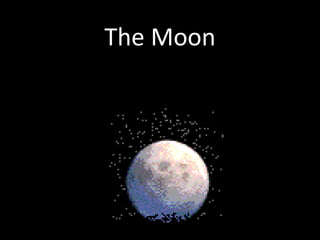
Understanding the Moon
- 1. The Moon
- 2. What is the Moon? • A large rock that orbits a planet • The Earth has 1 moon • Moons orbit planets • Planets orbit the sun
- 3. Moon Facts • The moon is 240,000 miles from Planet Earth. • The moon rotates counterclockwise. • There are holes on the moon’s surface called craters. • The moon gets its light from the reflection of the sun.
- 4. The Sun, Earth, & Moon
- 5. Animation of Earth, Moon, & Sun • Animated Movement of the Moon, Earth, & Sun
- 6. Why doesn’t the moon look the same? • As the moon orbits around the earth, the light from the sun shines on it. • From earth, we can only see certain portions of the lit moon. • It takes 1 month, approx. 29 days, for the moon to completely orbit the Earth.
- 7. Animation of the Moon Phases • Moon Phase Animation • Throughout a month, the moon’s position changes & we can only see some parts of the illuminated moon.
- 8. The Moon Causes Tides • Tides are caused by the gravitational pull of the moon. • There are two types of tides: High & Low • High tide occurs twice a day.
- 9. Tide Images • High Tide • Low Tide
- 10. Diagram of the Moon Phases The sun is always shining on the moon. From earth we can only see certain parts of the moon that are lit by the sun.
- 11. Diagram of the Moon Phases NEW MOON The moon is lit by the sun. However, the lit side of the moon cannot be seen from Earth. The moon appears black during the NEW MOON PHASE.
- 12. Diagram of the Moon Phases The moon is lit by the sun. We can only see a small portion of the lit moon from Earth. It is called a WAXING CRESCENT. WAXING CRESCENT
- 13. Diagram of the Moon Phases The moon is lit by the sun. We can see half of the lit moon from Earth. It is called a WAXING HALF MOON or a FIRST QUARTER MOON. WAXING HALF MOON (1ST QUARTER)
- 14. Diagram of the Moon Phases The moon is lit by the sun. We can see a lot of the lit moon from Earth. It is called a WAXING GIBBOUS. WAXING GIBBOUS
- 15. Diagram of the Moon Phases The moon is lit by the sun. We can see the entire lit moon from Earth. This is the FULL MOON phase. FULL MOON
- 16. Diagram of the Moon Phases The moon is lit by the sun. We can see a lot of the lit moon from Earth. This phase is called the WANING GIBBOUS. WANING GIBBOUS
- 17. Diagram of the Moon Phases WANING HALF MOON (LAST QUARTER) The moon is lit by the sun. We can see half of the lit moon from Earth. This is known as the WANING HALF MOON or LAST QUARTER.
- 18. Diagram of the Moon Phases WANING CRESCENT The moon is lit by the sun. We can only see a small portion of the lit moon from Earth. This is called the WANING CRESCENT.
- 19. The Phases Build Upon One Another:
- 20. Let’s look at the phases all together: • What does WAXING mean? • What does WANING mean? • What is a CRESCENT? • What is a GIBBOUS?